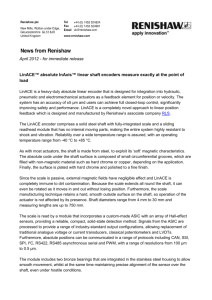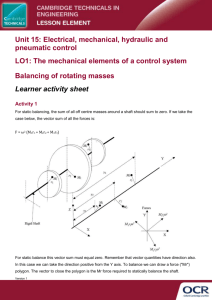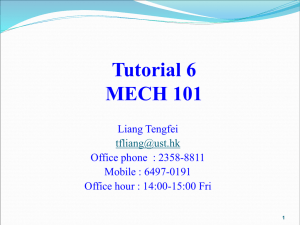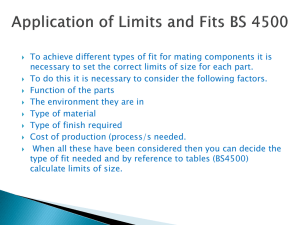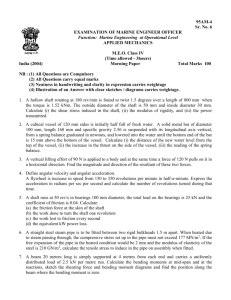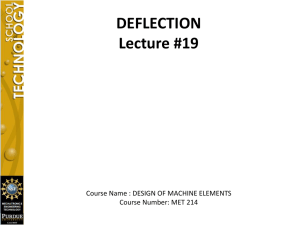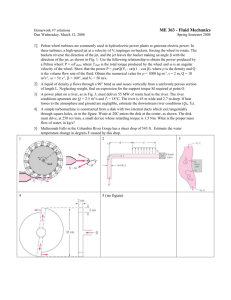Chapter 7
advertisement
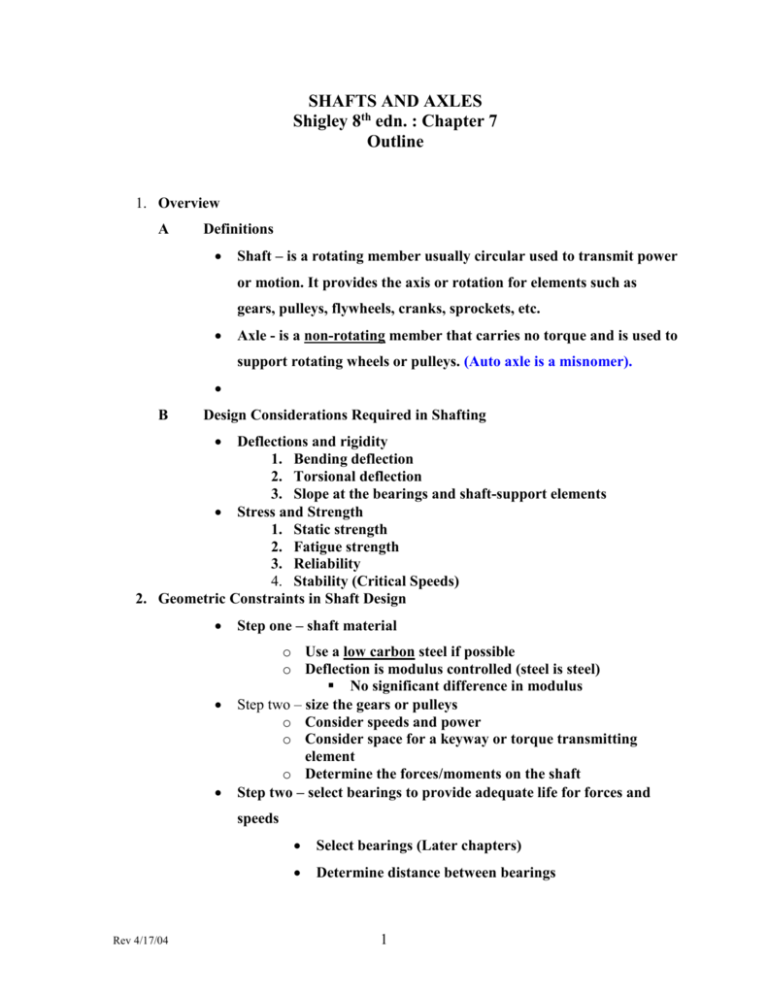
SHAFTS AND AXLES Shigley 8th edn. : Chapter 7 Outline 1. Overview A Definitions Shaft – is a rotating member usually circular used to transmit power or motion. It provides the axis or rotation for elements such as gears, pulleys, flywheels, cranks, sprockets, etc. Axle - is a non-rotating member that carries no torque and is used to support rotating wheels or pulleys. (Auto axle is a misnomer). B Design Considerations Required in Shafting Deflections and rigidity 1. Bending deflection 2. Torsional deflection 3. Slope at the bearings and shaft-support elements Stress and Strength 1. Static strength 2. Fatigue strength 3. Reliability 4. Stability (Critical Speeds) 2. Geometric Constraints in Shaft Design Step one – shaft material o Use a low carbon steel if possible o Deflection is modulus controlled (steel is steel) No significant difference in modulus Step two – size the gears or pulleys o Consider speeds and power o Consider space for a keyway or torque transmitting element o Determine the forces/moments on the shaft Step two – select bearings to provide adequate life for forces and speeds Rev 4/17/04 Select bearings (Later chapters) Determine distance between bearings 1 Step three - consider shaft stresses Step four – consider shaft deflections 3. Strength Constraints Typically static stresses are not significant in shaft design because fatigue and critical speeds play a more important role in design. Since shafts rotate, there is a strong likelihood of fatigue issues. Shaft Fluctuating Stresses – completely reversing due to rotation a K f 32M a d 3 32M m d 3 Eqn. (7-3) Torsional Stresses – Steady state and alternating torsional stress a K fs m K f 16Ta d 3 m K fs 16Tm d 3 Eqn. (7-4) Use equations 7-5 and 7-6 to get Maximum Distortion Energy, MDE equivalent stress a' ( a2 3 a2 ) 1 m' ( m2 3 m2 ) 2 1 2 Use modified Goodman equation for fatigue analysis on a shaft 1 a' m' n S e S ut Solve for the diameter, d (note: fortunately both bending and torsion have stress in terms of d3 ) Using MDE Modified Goodman results in equations 7-7 for n and 7-8 for the diameter, d. Other fatigue criteria [eqns. 7-9 to 7-14]. We will use MDE Goodman. See example7-1 for comparison of n with different criteria (Goodman will be the most conservative except for Soderberg) Rev 4/17/04 For more complete review see example 7-1 and 7-2 The potential for yield must be checked 2 4. Deflection Considerations – section 7-5 Deflection analysis requires complete geometric information Forces and locations of gears and pulleys Support locations, reaction loads, etc Consider as beam deflection With rotating shafts must have bearing supports Bearings tend to act as simple supports to shaft; bearings offer support w/ low frictional resistance to rotation See example 7-3 for deflection analysis If deflection is too great at a location, the needed shaft diameter is given by equation (7-17): d new d old n d y old y all 1/ 4 Where nd is the design factor And yall is the allowable deflection at that location. If slope is too great, use equation 7-18 to get a new diameter providing an acceptable slope: d new d old n d (dy / dx) old ( slope ) all 1/ 4 Where (slope)all is the allowable slope. Determine dnew/dold and multiply all diameters by this ratio. 5. Shaft Material All steels have about the same Young’s modulus so rigidity can’t be controlled by material alone (only by geometry) As usual, method of manufacture depends on volume 6. Hollow Shafts Rev 4/17/04 A hollow shaft can be used to reduce weight 3 Since the polar and bending moment of inertia are proportional to the 4th power of the diameter of a circular shaft and the cross sectional area is proportional to the 2nd power of the diameter, a hollow shaft can be designed to carry 90% of the torque capability of a solid shaft with much less weight Example from handout 7. Critical Speeds - Section 7-6 Shaft design requires critical speeds that much higher than the anticipated operational speeds of the applications [Critical speed at least 2X operating speed] Prime mover maximum speeds can be used as a guide to the required critical speeds for the shaft: i. I C engines ………………………. ~7000 rpm (max) ii. Electric motors ………………….. ~ 1800 to 3600 rpm iii. Gas Turbine engine …………….. ~ 12,000 + rpm See class notes and handouts for calculation of critical speeds Basic equation Shaft by itself nc 30 l2 gEI A l is the length; A is X-sectional area; γ is specific weight E is Young’s Modulus and I is the moment of inertia; nc is the critical speed in rpm; g is the acceleration of gravity (32.2 ft/sec2or 386 in/sec2). Shaft with one element [Rayleigh’s method ] nc 30 g st Where nc is the critical speed in rpm; g is the acceleration of gravity (32.2 ft/sec2or 386 in/sec2); st is the static Rev 4/17/04 4 deflection (ft. or in.).This is for a shaft with one element mounted on it, and the shaft is of negligible weight with respect to the element weight (often the case). Example problem with one mass - see class handout Equation for shaft with multiple elements nc 30 g ( w1 1 w2 2 ... wm m ) ( w1 12 w2 22 ... wm m2 ) or m g wi i nc i m w i 2 i i Where wi is the ith element weight; i is the total static deflection at the ith element location; g is the acceleration of gravity (32.2 ft/sec2or 386 in/sec2) Equation for shaft with 2 elements; this equation reduces to nc 30 g ( w1 1 w2 2 ) ( w1 12 w2 22 ) 8. Miscellaneous Shaft Components See section 7-7 Torque transfer elements o Keys o Splines o Setscrews o Pins o Press or shrink fits Element location devices o Cotter pin and washer o Nut and washer o Sleeve o Shaft shoulder o Ring and groove o Setscrew o Split hub or tapered two-piece hub o Collar and screw o Pins Rev 4/17/04 5 See class notes 9. Limits and Fits - see section 7-8 10. Shaft Design Summary - (for modification of an existing shaft) a. Find the uniform-diameter shaft that meets the slopes and deflection at the bearings and power transmission elements b. Consider the power transmission features: steps, shoulders, etc. c. Using the approximate geometry, perform a deflection and slope analysis d. Perform a strength analysis using MDE-Goodman theory. Examine feature by feature the keyways, bearing shoulders, gear shoulder, etc. Rev 4/17/04 6


